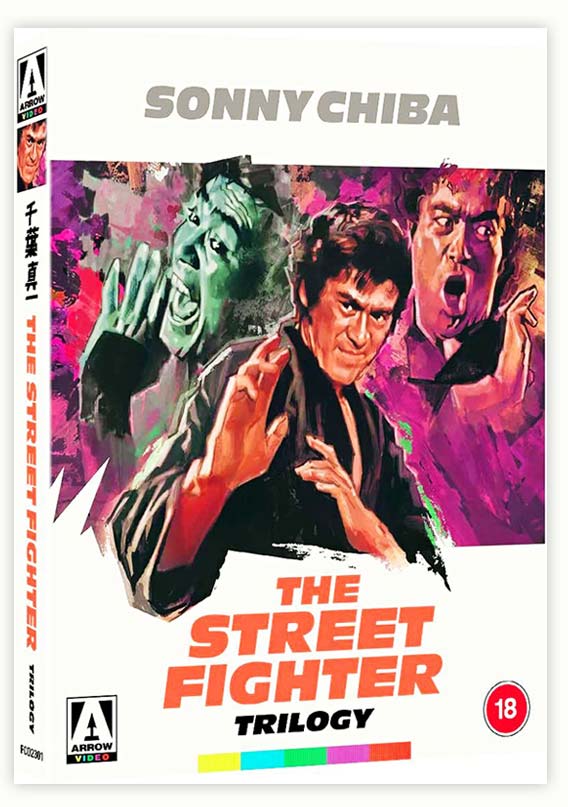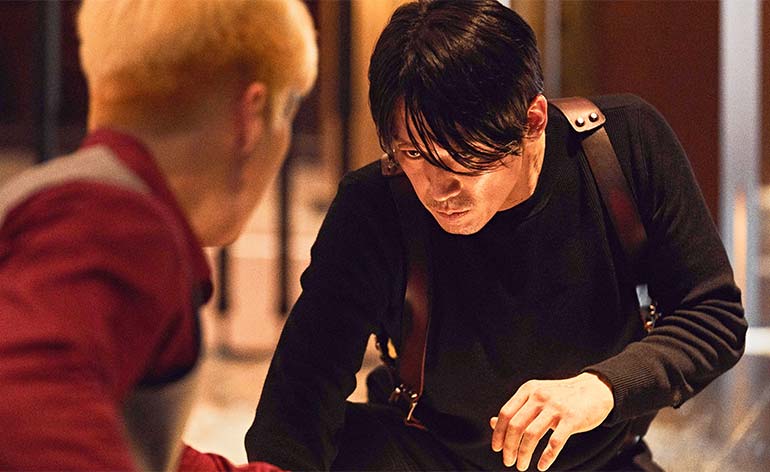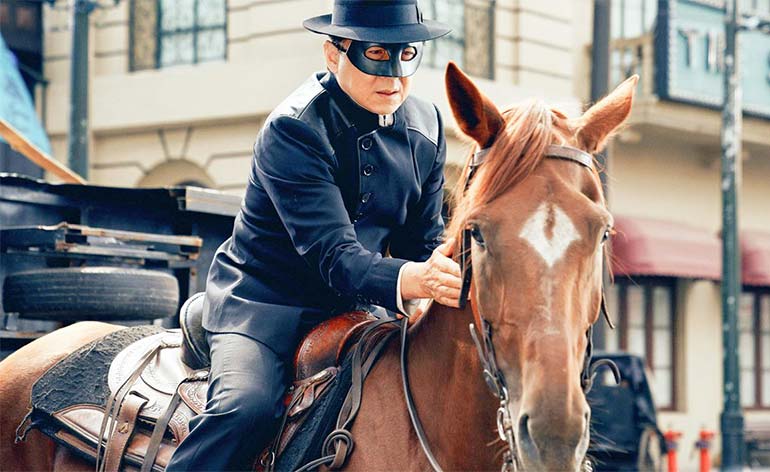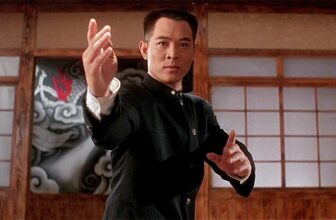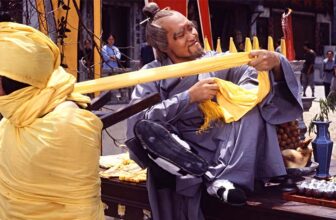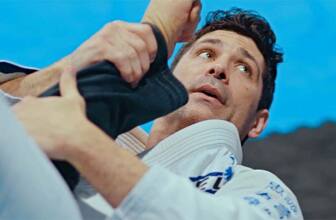
Making its UK Blu-ray debut, Arrow Video is proud to present The Street Fighter Trilogy in all its eye-popping, skull-crushing, throat-ripping glory!
The films that made Sonny Chiba a screen legend are out as a collection TODAY, 17th April, 2023 so order your copy NOW from Arrow Video or Amazon!
Trailer
Cast
Shinichi “Sonny” Chiba stars in all three films as “Takuma (Terry) Tsurugi”, a role that would bring him worldwide fame and cult status.
When he was a university student, Chiba earned a black belt in Kyokushin Karate in 1965 under the legendary Sensei Mas Oyama, going on to achieve his 4th Dan in 1984.
His martial arts training would also see Chiba attain belts in Togakure-ryū Ninpō Taijutsu (4th Dan), Goju-ryu Karate (2nd Dan), Shorinji Kempo (2nd Dan), Judo (2nd Dan) and Kendo (1st Dan).
Such was Chiba’s influence on Japanese cinema, that auteur director Quentin Tarantino paid tribute by giving him a guest-starring role as Hattori Hanzo, the owner of a sushi restaurant and retired samurai sword craftsman, in the bloody revenge epic “Kill Bill: Volume I” in 2003. Chiba sadly passed away on 19th August 2021 aged 82.
In the first film, Japanese actress Yutaka “Doris” Nakajima plays “Sarai Chuayut-Hammett”, daughter of a recently deceased oil tycoon. Goichi “Gerald” Yamada appears as “Rakuda (Ratnose) Zhang”, sidekick to Terry. Masashi (Milton) Ishibashi plays the murderous “Tateki (Junjo) Shikenbaru”, a role he would reprise in the second film.
“The Return of the Street Fighter” features Yōko Ichiji as “Pin Boke (Kitty)”, Masafumi Suzuki as “Kendō Masaoka” and Kaoru Nakajima as “Kazuko Masaoka”.
The third film in the series sees Reiko Ike starring as “Aya Ōwada”, Eizō Kitamura as “Seigen Ōwada”, Akira Shion as “Gō Ōwada”, Kōji Wada as “Takera Kunigami” and Etsuko Shihomi (Sue Shiomi) as “Huǒ Fèng”.
Masafumi Suzuki appears in all three films as karate master “Kendō Masaoka”.
Plot
The Street Fighter (1974)
Original Trailer
When an important business magnate dies, leaving billions to his daughter, the Mafia and Yakuza try to hire martial arts mercenary Takuma (Terry) Tsurugi to kidnap the daughter.
Tsurugi refuses after discovering that the gangsters are Yakuza. The gangsters resolve to kill Tsurugi as well as kidnap Sarai. Tsurugi immediately seeks out Sarai, who is being protected at the Nippon Seibukan dojo by her uncle, Kendō Masaoka, a Karate master.
Tsurugi offers to protect Sarai, and Masaoka agrees, against Sarai’s protests. The gangsters make several attempts to kill Tsurugi before they successfully kidnap Sarai. A tense and deadly confrontation awaits Tsurugi if he is to rescue Sarai!
The Return of the Street Fighter (1974)
Original Trailer
Mercenary karate master Tsurugi returns to thwart a plot by the American mafia, aided by a corrupt dojo master to take over karate dojos across Asia.
The Street Fighter’s Last Revenge (1974)
Original Trailer
Mercenary karate master Tsurugi is hired to retrieve a cassette tape which holds a very sensitive recording of governmental corruption.
Aletrnate Version: Terry Sugury is hired to recover one of two tapes containing a formula for making heroin. When he is double-crossed, Terry goes on the rampage to retrieve the tape.
Action
The Street Fighter
The fight action in The Street Fighter takes genuine karate techniques and blends it with the stylised choreography of 1970s martial arts films. They certainly like to use lots of bright red theatrical blood to emphasise the violence of the many fights.
When there are many opponents, they do the classic dancing about in the background until it is their turn to be dispatched by the hero.
There is a training sequence not unlike a 1970s Hong Kong kung fu film, featuring extreme and painful-looking exercises to toughen up the fighters.
A fight with a portly sensei at a karate school demonstrates some effective sweeps, blocks, counter attacks and throws that students of the various Japanese martial arts will be familiar with.
Like a scene out of an early Bond film, the bad guys find an innovative way of removing our hero’s vehicle from the road! A blind swordsman and his knife-wielding companion add to the scarlet-coloured violence in every scene they appear in. And if you were in any doubt about why this was the first film to receive an ‘X’ rating for violence in the USA, a rapist meets a particularly savage, but appropriate, demise!
The Return of the Street Fighter
The sequel wastes no time in getting down to some hardcore karate action.
A brief motorcycle chase through the streets of Tokyo (referenced in “Kill Bill” when The Bride seeks out Sonny Chiba’s character) leads our hero assuredly announcing his return with a fight at a police station! A visit to a Budo school delivers a demonstration of the various techniques and weapons practiced in karate training.
A fight in the confines of an office is mostly filmed with handheld cameras, putting the viewer in the thick of the action. This isn’t ‘shaky cam’ though, and every strike is clear to see. Perhaps something makers of modern action movies should take note of.
The obligatory training sequence gives Chiba a chance to show off some of the gymnastics he trained in as a teenager. He flips, kips, and handstands impressively around the gym before pumping some iron!
A fight with weapons-wielding assailants takes place on a snowy mountain, providing a fairly unique and interesting backdrop. The action switches from cold to hot with Chiba showing off his impressive physique, as he battles several foes in a steam room.
Being a sequel, the finale is ramped up to be bigger, bolder and literally more explosive than its predecessor.
The Street Fighter’s Last Revenge
Our hero returns, this time frequently adorning “Mission: Impossible”-style rubber facemask disguises.
The choreography in this third movie seems to be performed much more quickly and fluidly than it’s predecessors, although there are still plenty of solid karate strikes to enjoy.
There are some interesting opponents for Chiba to fight, including a high-kicking young girl called Huǒ Fèng, and what looks to be a long-lost member of the Three Amigos.
A Street Fighter movie isn’t complete without a visit to the Budo school and some more traditional-looking techniques played out in the training hall.
Huǒ Fèng, our high-kicking girl from the earlier fight, gets an exciting whirlwind scene of her own, letting the misogynistic men know that she is not to be trifled with.
It wouldn’t be a Street Fighter film without a rain-soaked battle, and this threequel is no exception. It leads to possibly the biggest, most flamboyant final fight of the trilogy.
Summary
The Street Fighter trilogy of films are genuine cult classics for fans and students of the history of cinema.
Emerging in the post-Bruce Lee hysteria of the mid-seventies, they were obviously influenced by the work of the Chinese martial arts icon. However they are imbued with a definite Japanese flavour, particularly with its hyperreal violence.
The cultish nature of the films would contribute to their influence on other filmmakers, particularly noticeable in auteur director Quentin Tarantino’s “Kill Bill” films. Touches such as the ‘X-ray punch’ would turn up in later films such as Jet Li‘s “Romeo Must Die” and the later Mortal Kombat video games.
The Street Fighter Theme Song
The restoration delivers a clean print with vibrant colours, especially so when the bright red theatrical blood is painted across the screen.
The fashions, soundtrack, cinematography and acting definitely date these films to the 1970s though.
Although the picture restoration on this Blu-ray edition is admirable, the cinematography, editing and directorial style really date these films. They look like they were made in the 1960s let alone the mid-70s. Having said that, this trilogy is a standout piece of cinematic history from a glorious era of martial arts mayhem ignited by the films of Bruce Lee.
Extras include an engaging interview with the legend himself Sonny Chiba. He gives lots fascinating behind-the-scenes anecdotes and is always interesting to listen to, often revealing his sly sense of humour.
Fans of Chinese kung fu movies are extremely well served, if not spoiled for choice. For fans of Japanese martial arts and culture, and students of cinema, these films are hugely influential and make for essential viewing.
Trivia
- Sonny Chiba originally trained to be an Olympic gymnast at college.
- Born Sadaho Maeda, he used the stage name “Chiba Shinichi” throughout his professional career. When New Line Cinema released the film “Gekitotsu! Satsujin” in the United States in 1974, they re-titled it “The Street Fighter” and billed its star as Sonny Chiba. Later, Chiba modified the name to “JJ Sonny Chiba”, wherein the initials stood for “Justice Japan”.
- The character Chiba played in “Kill Bill” was called Hattori Hanzō. This was also the name of a real life 16th century ninja master swordsman, a character played by Chiba in the “Shadow Warriors” television series.
- Chiba’s younger brother Jirō Yabuki guest stars as Gijun Shikenbaru in “The Street Fighter”.
- “The Street Fighter” was the first film to receive an X-rating solely for intense violence and mild gore.
- The title of the arcade fighting game Street Fighter (1987) was inspired by “The Street Fighter”.













